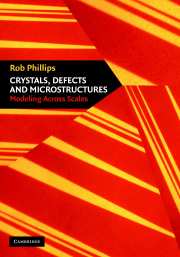Book contents
- Frontmatter
- Contents
- Preface
- Acknowledgements
- Notes on Units, Scales and Conventions
- Part One Thinking About the Material World
- Part two Energetics of Crystalline Solids
- 4 Energetic Description of Cohesion in Solids
- 5 Thermal and Elastic Properties of Crystals
- 6 Structural Energies and Phase Diagrams
- Part three Geometric Structures in Solids: Defects and Microstructures
- Part four Facing the Multiscale Challenge of Real Material Behavior
- References
- Index
5 - Thermal and Elastic Properties of Crystals
Published online by Cambridge University Press: 29 October 2009
- Frontmatter
- Contents
- Preface
- Acknowledgements
- Notes on Units, Scales and Conventions
- Part One Thinking About the Material World
- Part two Energetics of Crystalline Solids
- 4 Energetic Description of Cohesion in Solids
- 5 Thermal and Elastic Properties of Crystals
- 6 Structural Energies and Phase Diagrams
- Part three Geometric Structures in Solids: Defects and Microstructures
- Part four Facing the Multiscale Challenge of Real Material Behavior
- References
- Index
Summary
Thermal and Elastic Material Response
As yet, our discussion of modeling the energetics of crystalline solids has centered on the analysis of atomic configurations that are undisturbed by deformation, by the thermal vibrations that are inevitably present at finite temperatures or by defects. Before embarking on an analysis of the full-fledged defected solid, we begin with a consideration of geometric states that may be thought of as relatively gentle perturbations about the perfect crystal. In particular, the aim of the present chapter is to assess the energetics of both thermal vibrations and elastic deformations, with a treatment that is unified by the fact that in both cases the energy can be expanded about that of the perfect crystal which serves as the reference state.
Prior to examining the ways in which the methods of chap. 4 can be used to examine the energetics of both thermal vibrations and elastic deformations, we consider the significance of these excitations to the properties of materials at large. The methods of the present chapter feed into our quest to understand the properties of materials in several distinct ways. First, as will be described in the following paragraphs, a variety of important material properties involve the energetics of thermal vibration or elastic deformation directly, including the specific heat, the thermal conductivity, the thermal expansion and the elastic moduli themselves. However, in addition to the direct significance of the ideas to be presented here to the analysis of thermal properties, much of what we will have to say will form the methodological backdrop for our discussion of the thermodynamic ideas invoked to understand phase diagrams, diffusion and microstructural evolution.
- Type
- Chapter
- Information
- Crystals, Defects and MicrostructuresModeling Across Scales, pp. 210 - 252Publisher: Cambridge University PressPrint publication year: 2001



